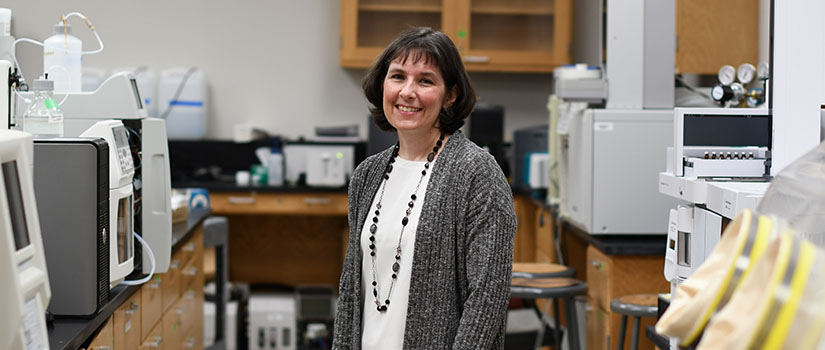Berge’s research aims for sustainable conversion
The Environmental Protection Agency reported in 2018 that the United States generated 292.4 million tons of municipal solid waste daily, a number that has undoubtedly increased. For the last three years, Civil and Environmental Engineering Associate Professor Nicole Berge has worked on research that aims to convert food waste to value-added products through a more sustainable and economically viable approach.
Berge’s four-year, National Science Foundation-sponsored research is examining sustainable conversion of wet wastes. She is working with Civil and Environmental Engineering Associate Professor Joseph Flora, Professor Ramesh Goel from the University of Utah, Professor Lubo Liu from California State University, Fresno and partnerships in China.
Concerns exist as food, energy and water systems adapt to stresses resulting from population growth, land use changes, and environmental pollution. The increased demand for these systems is expected to rise by as much as 80% by 2050. Berge’s research is examining resource recovery from food waste and addressing the potential transition of waste management process from the current take, make, consume and dispose model to a circular economy model, where wastes are reduced and their resources are efficiently extracted and reused.
It’s interesting to discover these different methods and realize that this could be a way to divert waste from a landfill and create something that might have a market value.
- Associate Professor Nicole Berge
According to Berge, wet organic wastes are undervalued and represent a significant source of resources, including nutrients, energy and water. Berge’s team is working to extract and reuse resources to create value-added products by using a hydrothermal carbonization (HTC) process, a more sustainable and potentially economically viable waste conversion method. Using this approach, wet wastes are converted into value-added products at low temperatures without the prerequisite of product drying. Food waste is ideal for the HTC process since it has high carbon, high energy and is very wet.
“I've been working on HTC since shortly after I started here [in 2009]. We've learned a lot about the process, but when we started to think about how it can be most beneficially used, we didn't have the answer and felt like there was still more work that needed to be done. This current research grew from that interest,” Berge says.
A significant shift in current waste management practices is required to make the HTC process work, since less than 3% of food wastes in the U.S. are currently diverted from landfills. But if carbonized, products generated from food and agricultural wastes have the potential to positively impact to the food, energy and water systems by offsetting the need for natural resources, externally generated energy, and irrigation water. Berge’s team has utilized the HTC process by adding different wet wastes and converting them to hydrochar, a carbon-based material known for being carbon and energy rich.
“There aren't a lot of good predictive tools that can determine what a product will look like if you carbonize food waste with a certain composition. We’re trying to develop such a tool and then understand the value of the products generated to see if it makes sense from an environmental standpoint to use them in a specific application,” Berge says.
Andres Sarrion was a visiting doctoral student from July to November 2021. Berge says he was instrumental in obtaining the current results and findings.
“Andres learned our carbonization methods and spent his time here carbonizing different components of food waste, and we've been continuing the work he started. He did most of the work to show our progress to date, which was impressive in only three months,” Berge says.
Sarrion’s work focused on the HTC process of food waste and the influence of its initial composition on the toxicity if using the hydrochar as a soil amendment. This may determine if rainwater would make the soil more toxic to the microorganisms.
The HTC process of individual food waste components was carried out by separating and characterizing the three main products obtained from this process - hydrochar, process water and a gas phase. Selecting the individual components of food waste was chosen according to the most consumed foods in the U.S. After creating different compositions by grinding and mixing them, the components were crushed to standardize the mixture while measuring their moisture. Each material was then carbonized at different temperatures and times.
“We found that meat waste was more toxic when carbonized at higher HTC temperatures, but the related toxicity decreased over a few days and was not dangerous to the soil,” Sarrion says. “Vegetables had a high toxicity when carbonized at temperatures below 250 degrees Celsius, but the toxicity decreased nearly 70% after five days of washing the hydrochar. Finally, a high toxicity was not found in fruit in all cases.”
Berge’s team has also started to gain a better understanding by attempting to evaluate the environmental sustainability of the HTC process. She intends to develop a model that can predict the composition of the hydrochar and process water based on waste composition.
“We just started doing lifecycle assessment work to build a systems-level model that describes the process and helps us better understand the true environmental impact,” Berge says. “We ultimately want to evaluate the environmental impact associated with how the products generated from the carbonization process are used. This model could be used as a decision support tool in which, we can make decisions on how to best use the generated products.”
Berge enjoys her current research since there has been increasing knowledge of the HTC process, especially since it was ignored for several decades after being developed in the 1950s.
“Prior to our initial work, very few had thought about using this as a technique to manage waste,” Berge says. “It’s interesting to discover these different methods and realize that this could be a way to divert waste from a landfill and create something that might have a market value.”
